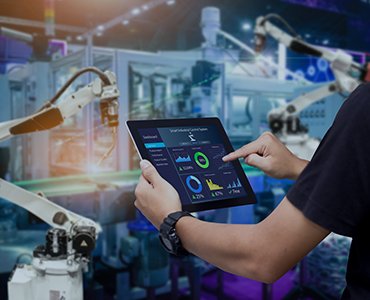Advantages at a glance:
-
Real-time transmission
-
State-of-the-art communication
-
Connect mobile applications
-
Use online services
Representational State Transfer (REST) is a modern architecture style for web services, used by many cloud services. With OMNITRACKER REST Web Services, you can easily create REST requests for external web services. Thus, you can get real-time information from external systems and make data available to third-party systems.
Real-time transmission
State-of-the-art communication
Connect mobile applications
Use online services
With the help of OMNITRACKER REST Web Services, the OMNITRACKER Interface Bus allows you to individually connect web services in various formats. The REST API is an interface for all purposes and it is used for data exchange and synchronization with distributed systems in real-time. It fulfills all defined conditions of a standardized interface. The REST programming interface enables continuous machine-to-machine (M2M) communication and creates a flexible architectural style that better meets the requirements of the modern internet.
Web services that are using REST architecture style do not need to record the state of a communication between server and client. In this way, you save time as well as memory and capacities, which significantly improves the performance (capability) during data transfer. As requests can be made regardless of the communication language, fast communication is possible. In this way, changes that are made in an external system are transmitted to OMNITRACKER almost in real-time.
REST design was introduced to take advantage of existing protocols more effectively.
It is characterized by its enormous flexibility and is not bound to fixed methods or resources (objects). Accordingly, it is possible to handle multiple types of requests and return different data formats. REST can be used for the most common protocols, e.g. HTTPS. You do not need to install any additional libraries or software tools.
In web-based scenarios, REST is the faster alternative to Simple Object Access Protocol (SOAP) or Web Service Description Language (WSDL). It consists of defined guidelines for flexible implementation. REST API is resource-efficient and therefore suitable for modern applications, such as mobile applications, serverless computing, or the Internet of Things (IoT).
With OMNITRACKER Rest Web Services, you can access XML, JSON, YAML, HTTP/S formats and other alternatives. For example, any programming language as well as any machine can read JavaScript Object Notation (JSON). Moreover, JSON is easy to use when programming.
OMNITRACKER REST Web Services contain both the OMNITRACKER REST Web Service Consumer and the OMNITRACKER REST Web Service Provider. This allows you to retrieve information from external systems (Consumer) and process it in OMNITRACKER, but also to provide information to third-party systems (Provider). REST API offers a standardized interface for the integration of third-party systems and is based on resources. For instance, an OMNITRACKER resource is an object that represents a customer, a company or an incident.
The script-based approach allows requests from external web services via OMNITRACKER Automation Interface. With this interface, you can completely control third-party systems, whereby downstream events are also triggered automatically. For this purpose, you can use web server-, client- or server-side scripts as well as the OMNITRACKER BPMN Engine. Of course, authentication takes place at the endpoint that is to be consumed. Here, you can choose between a manual and an automatic login. Generically registered user data are stored encrypted in OMNITRACKER, whereas manual entries are transmitted encrypted.
OMNITRACKER REST Web Service Provider provides your OMNITRACKER data to external systems. Endpoint mappings are used to define a server-side connection between the URL and a script. The called script can—for example—be a read-only script with read permissions or a script with more extensive write permissions.













Complete product integration into your own infrastructure
High product flexibility: easily customizable and extensible
Usable for all OMNITRACKER applications
Login with the help of the stored access data
Reduced administration efforts
Data exchange with external web services in real time

This process uses measurement and production data from machines and plants for maintenance at the time actually needed. Industry 4.0 machines have their own digital sensors with OPC UA (Open Platform Communications Unified Architecture) and can thus establish a direct connection with IoT Edge from Microsoft® Azure. These sensors constantly collect data—e.g. about the oil level and oil condition of a machine—and pass this information on to IoT Edge.
With OMNITRACKER REST Web Services, you can automatically query this data and import it into OMNITRACKER. Consequently, you receive all maintenance information and can maintain the machines and systems proactively and in line with requirements. Thus, downtimes and the risk of critical machine damages are minimized. With OMNITRACKER, you have a central system in which you can monitor your entire plant park regardless of location. You can also order the new oil and other consumables via the OMNITRACKER web shop and issue the corresponding maintenance order to your technician. Furthermore, you create clear diagrams about each individual machine with OMNILYTICS.